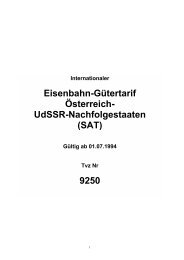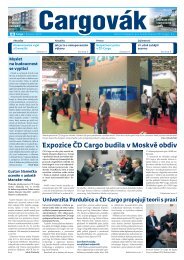You also want an ePaper? Increase the reach of your titles
YUMPU automatically turns print PDFs into web optimized ePapers that Google loves.
NOVINKA / NOVELTY<br />
Po Evropě 300 km rychlostí /<br />
Across Europe at 300 km/h<br />
Rychlovlaky konkurují nízkonákladovým leteckým společnostem.<br />
High-speed trains compete with low-cost air carriers.<br />
TEXT / TEXT BY DANA PÁLKOVÁ, DOPRAVA A LOGISTIKA FOTO / PHOTO BY ARCHIV / ARCHIVE<br />
Operátoři přidávají stále více tratí, zkracují<br />
dobu přepravy a nejnověji vylepšují<br />
cestování vymoženostmi, díky nimž se<br />
jim daří úspěšně konkurovat nízkonákladovým<br />
leteckým společnostem. Ačkoliv se<br />
po havárii rychlovlaku InterCityExpress<br />
(ICE) v německém Eschede v červnu 1998<br />
(zahynulo 101 lidí) po určitou dobu objevovaly<br />
dohady, zda jsou rychlovlaky bezpečné,<br />
zájem o ně stále roste. Koncem letošního<br />
ledna už bylo v Evropě ve výstavbě více než<br />
4000 km vysokorychlostních tratí a dalších<br />
více než 8000 km se plánuje.<br />
První byli Italové<br />
Bezkonkurenčně vede Francie, která sice<br />
není zemí s prvním vysokorychlostním vlakem<br />
v Evropě (prvenství drží Italové s vlakem<br />
Direttissima, uvedeným do provozu<br />
v roce 1978), ale zato má největší rozsah sítí.<br />
Od roku 1981, kdy byl zahájen provoz prvního<br />
vysokorychlostního vlaku (tehdy LGV),<br />
rozšířila síť po celé zemi včetně sousedních<br />
států. Později LGV nahradily TDV a od února<br />
letošního roku se Francie posunula ještě<br />
dál, když představila AGV, první superrychlý<br />
vlak bez lokomotivy.<br />
Zatímco TGV dosáhnou na běžné trati<br />
rychlosti 320 km/h, AGV bude jezdit rychlostí<br />
360 km/h. Umožní mu to revoluční design<br />
spočívající v uložení motorů pod každým<br />
z vagónů, což znamená, že vlak nepotřebuje<br />
lokomotivu. Očekává se, že za tři hodiny<br />
ujede tisíc kilometrů.<br />
Air France cítí konkurenci vlaků<br />
Nepříjemné důsledky nástupu rychlovlaků musely<br />
přiznat i francouzské aerolinie Air France.<br />
Přesto, že spolu s holandskou KLM představují<br />
největší evropskou leteckou společnost, právě<br />
vzhledem k rozšiřující se síti TGV vlaků budou<br />
muset do roku 2016 snížit počet pracovních<br />
míst o 4 000. „Očekáváme, že konkurence TGV<br />
vlaků se ještě zvýší. Už jsme informovali odbory,<br />
že se společnost bude muset podle toho zařídit,“<br />
oznámily Air France.<br />
Tr<strong>as</strong>a přes La Manche<br />
V těsném závěsu za Francouzi jsou <strong>Š</strong>panělé.<br />
V únoru k rychlotrati mezi Madridem a Sevillou<br />
přidali další tr<strong>as</strong>u mezi Madridem<br />
a Barcelonou. Jestliže se systém Alta Velocidad<br />
Española (systém vysokorychlostních<br />
tratí ve <strong>Š</strong>panělsku) bude vyvíjet podle plánu,<br />
do roku 2020 by měl mít už kolem 7000 km.<br />
Němci, zejména díky Siemensu, měli<br />
šanci přijít s rychlovlaky přibližně ve stejném<br />
období jako Francouzi. S výstavbou<br />
první rychlotrati se tu začalo krátce po spuštění<br />
LGV. Jenže vzhledem k právním sporům<br />
se vlaky InterCityExpress (ICE) dostaly<br />
na trať až deset let poté, co Francouzi<br />
uvedli do provozu druhý model TGV. I teď<br />
měli šanci dostat se do popředí. Loni v říjnu<br />
Historie<br />
Vlaky byly kdysi doménou lidí, kteří si zvykli<br />
kochat se pohledem na krajinu pomalu ubíhající<br />
za okny. Dnes už to ale neplatí. Především<br />
konec 90. let minulého a začátek nového<br />
století je obdobím nástupu rychlovlaků, které<br />
postupně zrychlují pohyb po Evropě.<br />
History<br />
Trains used to be the domain of people who<br />
luxuriated in the landscapes slowly p<strong>as</strong>sing by<br />
their window. But that’s no longer the c<strong>as</strong>e.<br />
The end of the 1990s and the beginning of the<br />
new century h<strong>as</strong> been a period of <strong>as</strong>cendancy<br />
for high-speed trains, which are gradually<br />
speeding up travel across Europe.<br />
Operators are adding more and more<br />
lines, shortening transport times and,<br />
most recently, are improving travel with<br />
conveniences that help them compete with<br />
low-cost air carriers. After a high-speed<br />
InterCityExpress (ICE) accident of the in<br />
the German city of Eschede in June 1998, in<br />
which 101 people died, there w<strong>as</strong> speculation<br />
about whether high-speed trains were<br />
safe. But interest in them h<strong>as</strong> continued to<br />
grow. At the end of January this year there<br />
w<strong>as</strong> more than 4,000 km of high-speed rail<br />
track under construction in Europe, with an<br />
additional 8,000 km planned.<br />
Italians were fi rst<br />
Although it w<strong>as</strong> not the country with the<br />
fi rst high-speed train in Europe (the Italians<br />
hold this honour with the Direttissima train,<br />
put into operation in 1978), France is the<br />
undisputed leader with the widest-ranging<br />
network. Since 1981, when the first highspeed<br />
train operation w<strong>as</strong> begun (with the<br />
LGV at that time), the network h<strong>as</strong> spread<br />
across the entire country, and to neighbouring<br />
countries <strong>as</strong> well. The LGV w<strong>as</strong> later replaced<br />
by the TGV, and France moved things<br />
along even further this January when it introduced<br />
the AGV, the fi rst super-f<strong>as</strong>t train<br />
without a locomotive.<br />
While the TGV reaches speeds of 320<br />
km/h on regular tracks, the AGV will travel<br />
at 360 km/h. This is made possible by a revolutionary<br />
design that places motors under<br />
each carraige, which means that the train<br />
does not need a locomotive. It is expected to<br />
travel 1,000 km in three hours.<br />
Air France senses<br />
a competitive struggle<br />
Even Air France h<strong>as</strong> to concede unple<strong>as</strong>ant<br />
consequences of the rise of the high-speed<br />
trains. Despite the fact that Air France-<br />
KLM is the largest air carrier in Europe, Air<br />
France will have to cut 4,000 jobs by 2016<br />
because of the expanding TGV network. “We<br />
expect that the competition from TGV trains<br />
oznámili záměr uvést jako první evropská<br />
země do komerčního provozu vlak na magnetickém<br />
polštáři (maglev), ale ani to jim<br />
nevyšlo. Maglev měl propojit mnichovské<br />
letiště s centrem, jenže kvůli vysokým předpokládaným<br />
nákladům (z 1,8 miliardy se vyšplhaly<br />
na 3,2 miliardy eur) německá vláda<br />
koncem března projekt zrušila.<br />
Největším posunem, na který zvlášť zareagovaly<br />
letecké společnosti, byla však<br />
modernizace trati ve Velké Británii koncem<br />
minulého roku. Ostrovní země je propojená<br />
s kontinentální Evropou sítí rychlovlaků<br />
společnosti Eurostar s provozem pod<br />
kanálem La Manche. Když se od listopadu<br />
2007 cestování na populárních tr<strong>as</strong>ách Paříž<br />
– Londýn a Brusel – Londýn zkrátilo <strong>as</strong>i<br />
o půl hodiny, železnice si pozici vůči aero-<br />
will incre<strong>as</strong>e and we have already informed<br />
our unions that the company will have to act<br />
accordingly,” Air France announced.<br />
Rail line across the<br />
English Channel<br />
The Spaniards are right behind the French.<br />
In February they added a high-speed track<br />
between Madrid and Barcelona to their existing<br />
track between Madrid and Seville. If<br />
the Alta Velocidad Española system (the<br />
Spanish high-speed rail network) develops<br />
according to plan, it should comprise<br />
7,000 km of track by 2020.<br />
The Germans, especially due to Siemens,<br />
had a chance to come out with highspeed<br />
trains at roughly the same time <strong>as</strong><br />
the French. They began construction on<br />
NOVELTY / NOVINKA<br />
their fi rst high-speed track shortly after the<br />
launch of the LGV. But because of legal disputes,<br />
InterCityExpress (ICE) trains went<br />
into service 10 years after the French put<br />
their second model, the TGV, into operation.<br />
They had another chance to take the lead<br />
recently. L<strong>as</strong>t October, Germany announced<br />
its intention to become the fi rst European<br />
country to put a train on magnetic cushions<br />
(maglev) into commercial operation, but it<br />
did not work out. The maglev w<strong>as</strong> supposed<br />
to connect Munich Airport with the city centre,<br />
but because of expected cost overruns<br />
(it jumped from EUR 1.8 billion to 3.2 billion),<br />
the German government cancelled the<br />
project at the end of March.<br />
But the greatest step forward, one which<br />
air carriers in particular reacted to, w<strong>as</strong> the<br />
38 REVUE PRO DOPRAVU A LOGISTIKU REVUE FOR TRANSPORT AND LOGISTICS 39









